Operational Data Analysis of a Battery Energy Storage System to Support Wind Energy Generation
Abstract
1. Introduction
- Lagoa dos Ventos Wind Farm—Located in the state of Piauí, with an installed capacity of 399 MW;
- Osório Wind Farm—Located in the state of Rio Grande do Sul, with 300 MW of installed capacity;
- Alto do Sertão I Wind Complex—Located in the state of Bahia, with an installed capacity of 293.6 MW.
2. Application of Energy Storage Systems in Wind Generation
3. Case Study: BESS Operation in a Wind Complex in Northeastern Brazil
3.1. Simulation Results-HOMER Pro
3.2. Results of Actual Operation of the Wind/BESS System
3.2.1. Power Factor Correction
3.2.2. Voltage Control
3.2.3. Power Factor Smoothing
3.2.4. Frequency Control
3.2.5. Time-Shift
4. Conclusions
Author Contributions
Funding
Data Availability Statement
Conflicts of Interest
References
- de Araujo Silva Júnior, W.; Vasconcelos, A.; Arcanjo, A.C.; Costa, T.; Nascimento, R.; Pereira, A.; Jatobá, E.; Filho, J.B.; Barreto, E.; Dias, R.; et al. Characterization of the Operation of a BESS with a Photovoltaic System as a Regular Source for the Auxiliary Systems of a High-Voltage Substation in Brazil. Energies 2023, 16, 1012. [Google Scholar] [CrossRef]
- Abdin, Z.; Khalilpour, K.R. Single and polystorage technologies for renewable-based hybrid energy systems. In Polygeneration with Polystorage for Chemical and Energy Hubs; Elsevier: Amsterdam, The Netherlands, 2019; pp. 77–131. [Google Scholar] [CrossRef]
- de O. Santos, D.S., Jr.; de Mattos Neto, P.S.; de Oliveira, J.F.; Siqueira, H.V.; Barchi, T.M.; Lima, A.R.; Madeiro, F.; Dantas, D.A.; Converti, A.; Pereira, A.C.; et al. Solar Irradiance Forecasting Using Dynamic Ensemble Selection. Appl. Sci. 2022, 12, 3510. [Google Scholar] [CrossRef]
- GWE Council. GWEC Global Wind Report 2022; Global Wind Energy Council: Brussels, Belgium, 2022. [Google Scholar]
- ANEEL. Brazilian Electrical Matrix. Available online: https://app.powerbi.com/view?r=eyJrIjoiNjc4OGYyYjQtYWM2ZC00YjllLWJlYmEtYzdkNTQ1MTc1NjM2IiwidCI6IjQwZDZmOWI4LWVjYTcDZhMi05MmQ0LWNGU5YzAxNzBlMSIsImMiOjR9 (accessed on 13 March 2022).
- UN Climate Change Conference UK 2021. A Pivotal Moment in the Fight against Climate Change. Available online: https://ukcop26.org/uk-presidency/what-is-a-cop/ (accessed on 25 November 2022).
- United Nations. COP26: Together for Our Planet. Available online: https://www.un.org/en/climatechange/cop26 (accessed on 27 November 2022).
- Ellahi, M.; Abbas, G.; Khan, I.; Koola, P.M.; Nasir, M.; Raza, A.; Farooq, U. Recent approaches of forecasting and optimal economic dispatch to overcome intermittency of wind and photovoltaic (PV) systems: A review. Energies 2019, 12, 4392. [Google Scholar] [CrossRef]
- Price, T.J. James Blyth—Britain’s first modern wind power pioneer. Wind. Eng. 2005, 29, 191–200. [Google Scholar] [CrossRef]
- Scholarly Community Encyclopedia. History of Wind Power. Available online: https://encyclopedia.pub/entry/28212 (accessed on 29 November 2022).
- Bezerra, F.D. Opportunities for the Northeast in Wind Energy; Bank of Northeast Brazil: Fortaleza, Brazil, 2021. Available online: https://www.bnb.gov.br/s482-dspace/handle/123456789/974 (accessed on 21 November 2022).
- Chen, H.; Cong, T.N.; Yang, W.; Tan, C.; Li, Y.; Ding, Y. Progress in electrical energy storage system: A critical review. Prog. Nat. Sci. 2009, 19, 291–312. [Google Scholar] [CrossRef]
- Souza, A.C.M.D. Application of Battery Energy Storage Systems for Power Smoothing in Wind Farms. Bachelor’s Thesis, UFPE, Recife, Brazil, 2022. [Google Scholar]
- CPG Click Oil and Gas. What are the Main Wind Farms in Brazil? Available online: https://clickpetroleoegas.com.br/blog/energia-eolica/quais-sao-os-principais-parques-eolicos-no-brasil/ (accessed on 11 December 2022).
- ABEEolica. Infovento ABEEolica. Technical Report, Agência Brasileira de Energia Eólica. 2022. Available online: https://abeeolica.org.br/wp-content/uploads/2022/08/2022_07_InfoVento26-1.pdf (accessed on 7 December 2022).
- de Siqueira, L.M.S.; Peng, W. Control strategy to smooth wind power output using battery energy storage system: A review. J. Energy Storage 2021, 35, 102252. [Google Scholar] [CrossRef]
- Sauer, D.; Fuchs, G.; Lunz, B.; Leuthold, M. Technology Overview on Electricity Storage—Overview on the Potential and on the Deployment Perspectives of Electricity Storage Technologies; Institute for Power Electronics and Electrical Drives (ISEA), RWTH Aachen University: Aachen, Germany, 2012. [Google Scholar]
- Liu, M.; Cao, X.; Cao, C.; Wang, P.; Wang, C.; Pei, J.; Lei, H.; Jiang, X.; Li, R.; Li, J. A Review of Power Conversion Systems and Design Schemes of High-Capacity Battery Energy Storage Systems. IEEE Access 2022, 10, 52030–52042. [Google Scholar] [CrossRef]
- Farris, A. The Intermittency Problem. Available online: http://www.energybc.ca/intermittency.html (accessed on 13 December 2022).
- Dantas, N.K.; Souza, A.C.; Vasconcelos, A.S.; de Junior, W.A.; Rissi, G.; Dall’Orto, C.; Maciel, A.M.; Castro, J.F.; Liu, Y.; Rosas, P. Impact Analysis of a Battery Energy Storage System Connected in Parallel to a Wind Farm. Energies 2022, 15, 4586. [Google Scholar] [CrossRef]
- Rosas, P.; Luna, G.; Medeiros, L.H.; Luiz, P.; Furlanetto, P.; Moraes, M.; Ramos, F.; Teixeira, W.; Silva, R.P.; Xinjian, C.; et al. BESS Applied to Wind Power Smoothing. In Proceedings of the Brazil Windpower Conference and Exhibition, Rio de Janeiro, Brazil, 7–9 August 2018. [Google Scholar]
- Eyer, J.; Corey, G. Energy storage for the electricity grid: Benefits and market potential assessment guide. Sandia Natl. Lab. 2010, 20, 5. [Google Scholar]
- Usama, M.U.; Kelle, D.; Baldwin, T. Utilizing spinning reserves as energy storage for renewable energy integration. In Proceedings of the 2014 Clemson University Power Systems Conference, Clemson, SC, USA, 11–14 March 2014; pp. 1–5. [Google Scholar] [CrossRef]
- Bak, Y.; Lee, J.S.; Lee, K.B. Low-voltage ride-through control strategy for a grid-connected energy storage system. Appl. Sci. 2018, 8, 57. [Google Scholar] [CrossRef]
- Eckroad, S. Energy Storage for Grid Connected Wind Generation Applications; EPRI-DOE Handbook Supplement, Technical Report, 1008703; EPRI: Palo Alto, CA, USA, 2004. [Google Scholar]
- Gonzalez-Longatt, F.M.; Alhejaj, S.M. Enabling inertial response in utility-scale battery energy storage system. In Proceedings of the 2016 IEEE Innovative Smart Grid Technologies-Asia (ISGT-Asia), Melbourne, VIC, Australia, 28 November–1 December 2016; pp. 605–610. [Google Scholar] [CrossRef]
- Delille, G.; Francois, B.; Malarange, G. Dynamic frequency control support by energy storage to reduce the impact of wind and solar generation on isolated power system’s inertia. IEEE Trans. Sustain. Energy 2012, 3, 931–939. [Google Scholar] [CrossRef]
- Jorgensen, J.; Mai, T.; Brinkman, G. Reducing Wind Curtailment through Transmission Expansion in a Wind Vision Future; Technical Report; National Renewable Energy Lab (NREL): Golden, CO, USA, 2017. [Google Scholar] [CrossRef]
- Castaneda, J. Wind Storage Enhanced Transmission Research and Development: Final Project Report; Quanta Technology. California Energy Commission: Sacramento, CA, USA, 2012. [Google Scholar]
- Nascimento, R.; Ramos, F.; Pinheiro, A.; de Araujo Silva Junior, W.; Arcanjo, A.M.; Filho, R.F.D.; Mohamed, M.A.; Marinho, M.H. Case Study of Backup Application with Energy Storage in Microgrids. Energies 2022, 15, 9514. [Google Scholar] [CrossRef]
- Ramos, F.; Pinheiro, A.; Nascimento, R.; de Araujo Silva Junior, W.; Mohamed, M.A.; Annuk, A.; Marinho, M.H. Development of Operation Strategy for Battery Energy Storage System into Hybrid AC Microgrids. Sustainability 2022, 14, 13765. [Google Scholar] [CrossRef]
- Zhao, H.; Wu, Q.; Hu, S.; Xu, H.; Rasmussen, C.N. Review of energy storage system for wind power integration support. Appl. Energy 2015, 137, 545–553. [Google Scholar] [CrossRef]
- Sukumar, S.; Marsadek, M.; Agileswari, K.; Mokhlis, H. Ramp-rate control smoothing methods to control output power fluctuations from solar photovoltaic (PV) sources—A review. J. Energy Storage 2018, 20, 218–229. [Google Scholar] [CrossRef]
- van Haaren, R.; Morjaria, M.; Fthenakis, V. An energy storage algorithm for ramp rate control of utility scale PV (photovoltaics) plants. Energy 2015, 91, 894–902. [Google Scholar] [CrossRef]
- Martins, J.; Spataru, S.; Sera, D.; Stroe, D.I.; Lashab, A. Comparative Study of Ramp-Rate Control Algorithms for PV with Energy Storage Systems. Energies 2019, 12, 1342. [Google Scholar] [CrossRef]
- Pinheiro, A.L.; Ramos, F.O.; Neto, M.M.B.; Lima, R.N.; Bezerra, L.G.S.; Washington, A. A Review and Comparison of Smoothing Methods for Solar Photovoltaic Power Fluctuation Using Battery Energy Storage Systems. In Proceedings of the 2021 IEEE PES Innovative Smart Grid Technologies Conference—Latin America (ISGT Latin America), Lima, Peru, 15–17 September 2021; pp. 1–5. [Google Scholar] [CrossRef]
- Solanki, S.G.; Ramachandaramurthy, V.K.; Shing, N.Y.K.; Tan, R.H.; Tariq, M.; Thanikanti, S.B. Power smoothing techniques to mitigate solar intermittency. In Proceedings of the 2019 International Conference on Electrical, Electronics and Computer Engineering (UPCON), Aligarh, India, 8–10 November 2019; pp. 1–6. [Google Scholar] [CrossRef]
- Wei, Z.; Moon, B.Y.; Joo, Y.H. Smooth Wind Power Fluctuation Based on Battery Energy Storage System for Wind Farm. J. Electr. Eng. Technol. 2014, 9, 2134–2141. [Google Scholar] [CrossRef]
- Li, X.; Hui, D.; Lai, X. Battery Energy Storage Station (BESS)-Based Smoothing Control of 488 Photovoltaic (PV) and Wind Power Generation Fluctuations. IEEE Trans. Sustain. Energy 2013, 4, 464–473. [Google Scholar] [CrossRef]
- Deng, Z.; Xu, Y.; Gu, W.; Fei, Z. Finite-time convergence robust control of battery energy storage system to mitigate wind power fluctuations. Int. J. Electr. Power Energy Syst. 2017, 91, 144–154. [Google Scholar] [CrossRef]
- Lamsal, D.; Sreeram, V.; Mishra, Y.; Kumar, D. Smoothing control strategy of wind and photovoltaic output power fluctuation by considering the state of health of battery energy. IET Renew. Power Gener. 2019, 13, 578–586. [Google Scholar] [CrossRef]
- Zheng, Y.; Hill, D.; Meng, K.; Luo, F.; Dong, Z. Optimal Short-term Power Dispatch Scheduling for a Wind Farm with Battery Energy Storage System. IFAC-PapersOnLine 2015, 48, 518–523. [Google Scholar] [CrossRef]
- Agência NE9. Discover the City in the Northeast that could Win the Title of Capital of the Winds. Available online: https://www.ne9.com.br/conheca-a-cidade-do-nordeste-que-pode-virar-a-capital-nacional-dos-ventos/ (accessed on 27 December 2022).
- Oficina das Palavras. The Grandeur of Wind Farms Changes the Routine of João Câmara (RN). Available online: https://grupoodp.com.br/grandiosidade-dos-parques-eolicos-muda-rotina-de-joao-camara-rn/ (accessed on 27 December 2022).
- Lima, M.C.C.; Pontes, L.P.; Vasconcelos, A.S.M.; de Araujo Silva Junior, W.; Wu, K. Economic Aspects for Recycling of Used Lithium-Ion Batteries from Electric Vehicles. Energies 2022, 15, 2203. [Google Scholar] [CrossRef]
- Costa, T.S.; Villalva, M.G. Technical Evaluation of a PV-Diesel Hybrid System with Energy Storage: Case Study in the Tapajós-Arapiuns Extractive Reserve, Amazon, Brazil. Energies 2020, 13, 2969. [Google Scholar] [CrossRef]

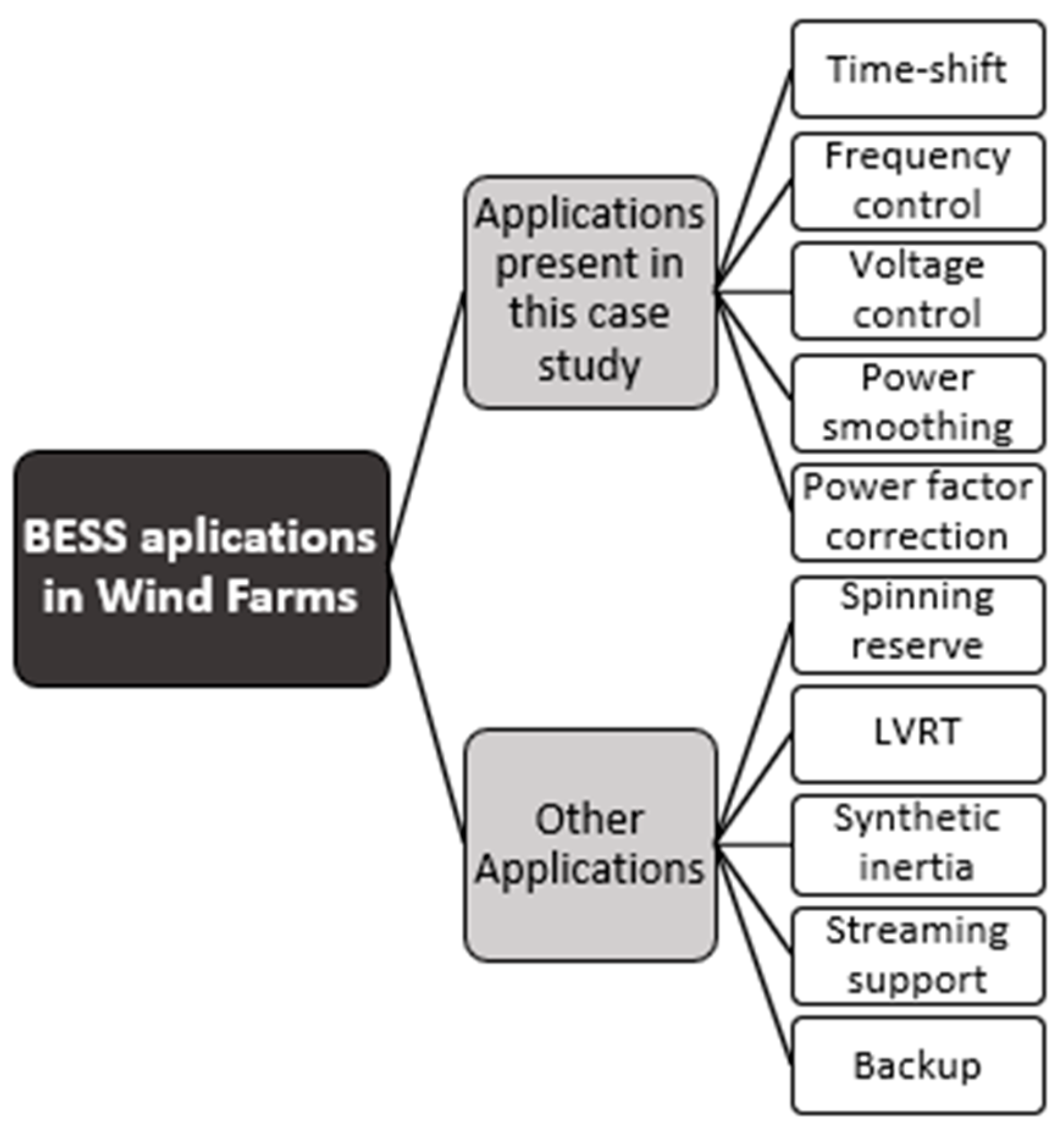
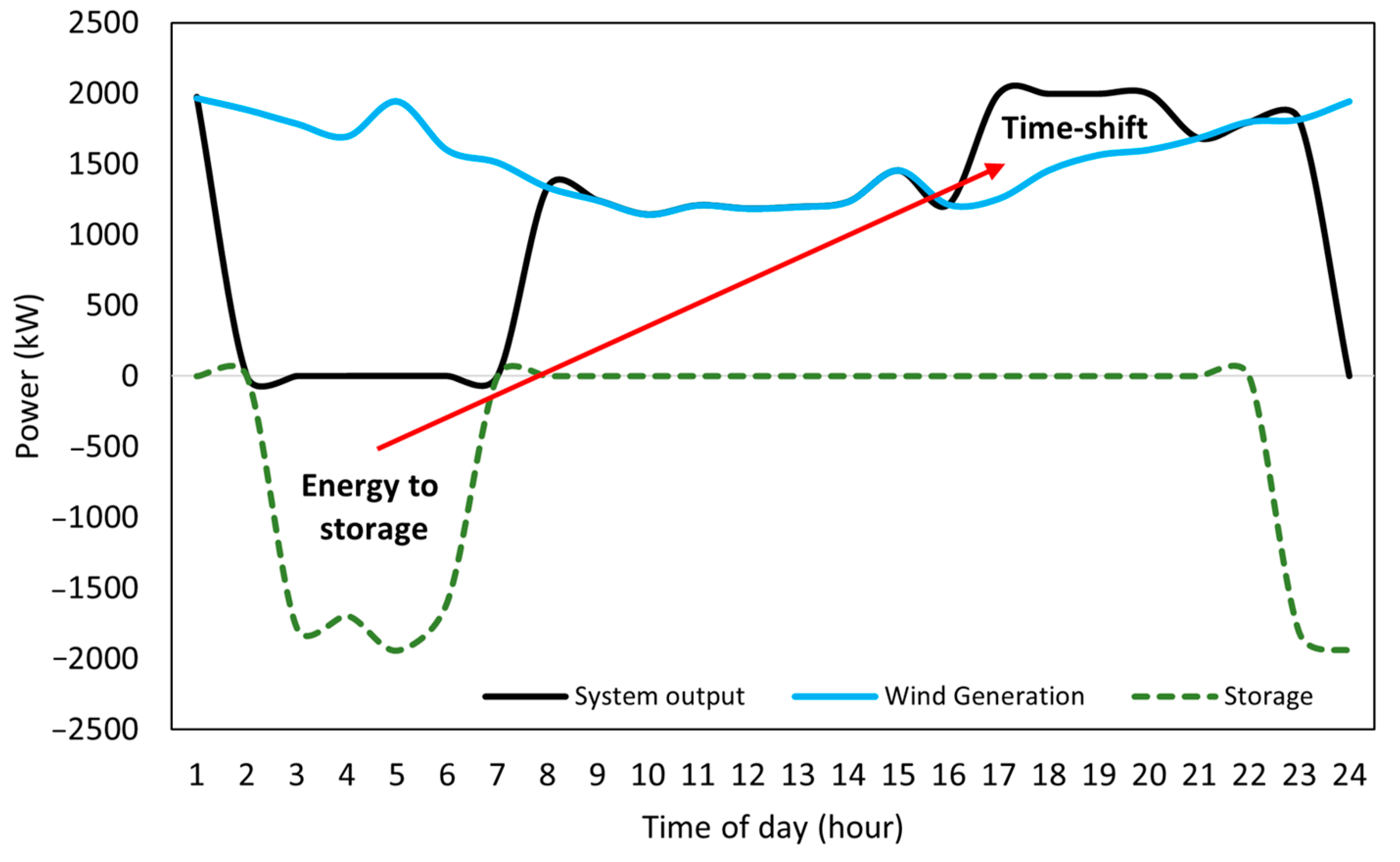

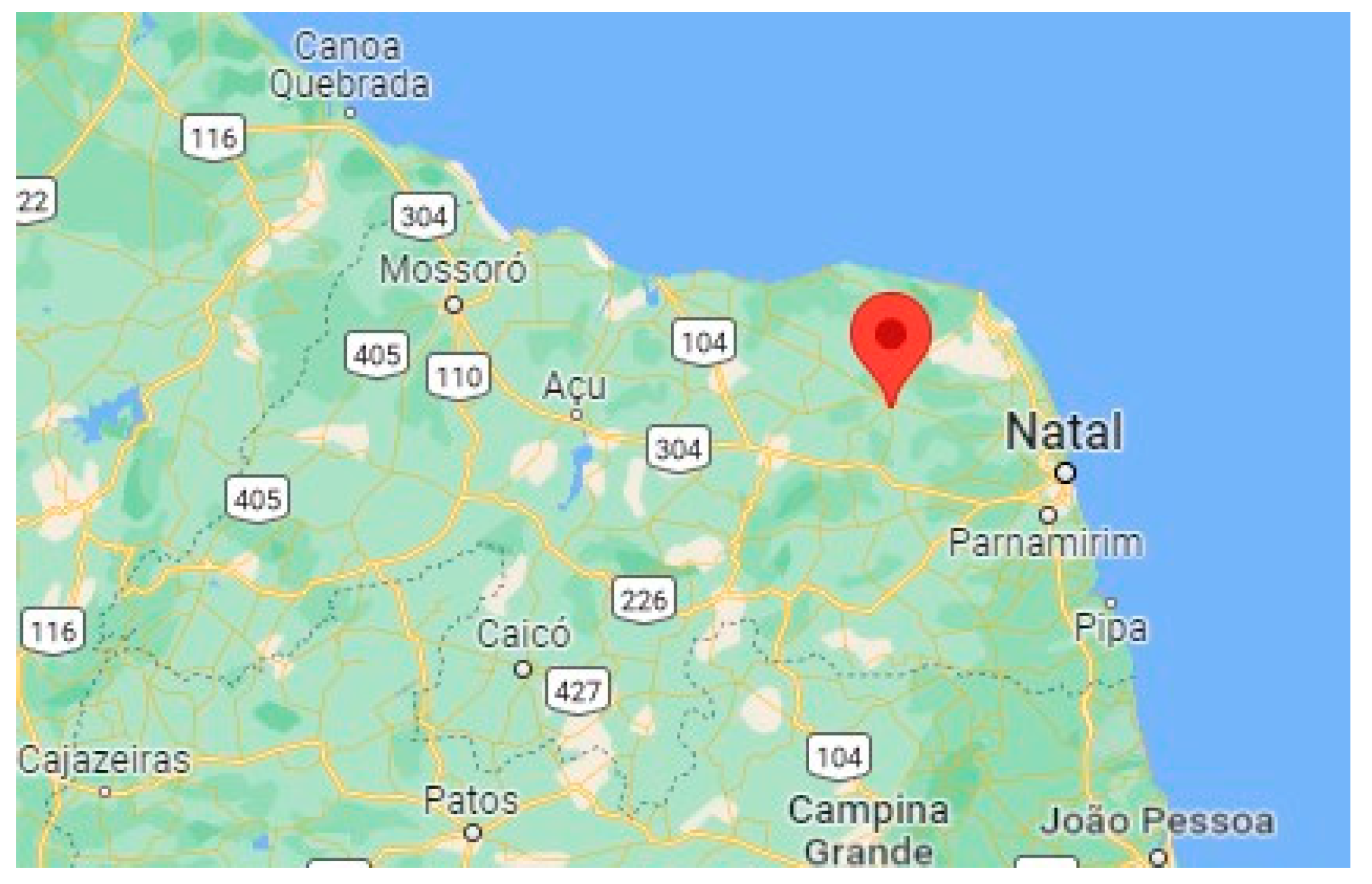
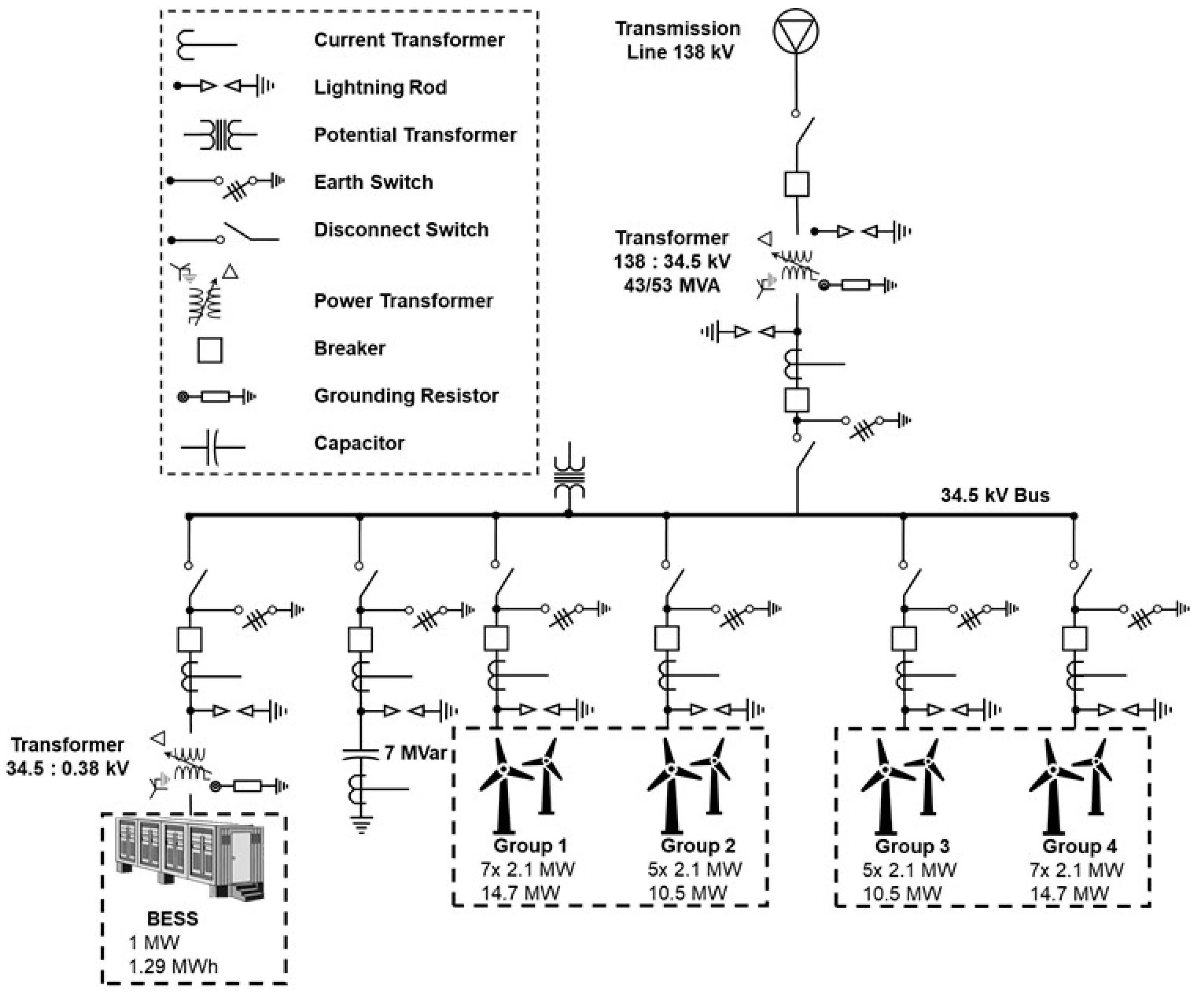
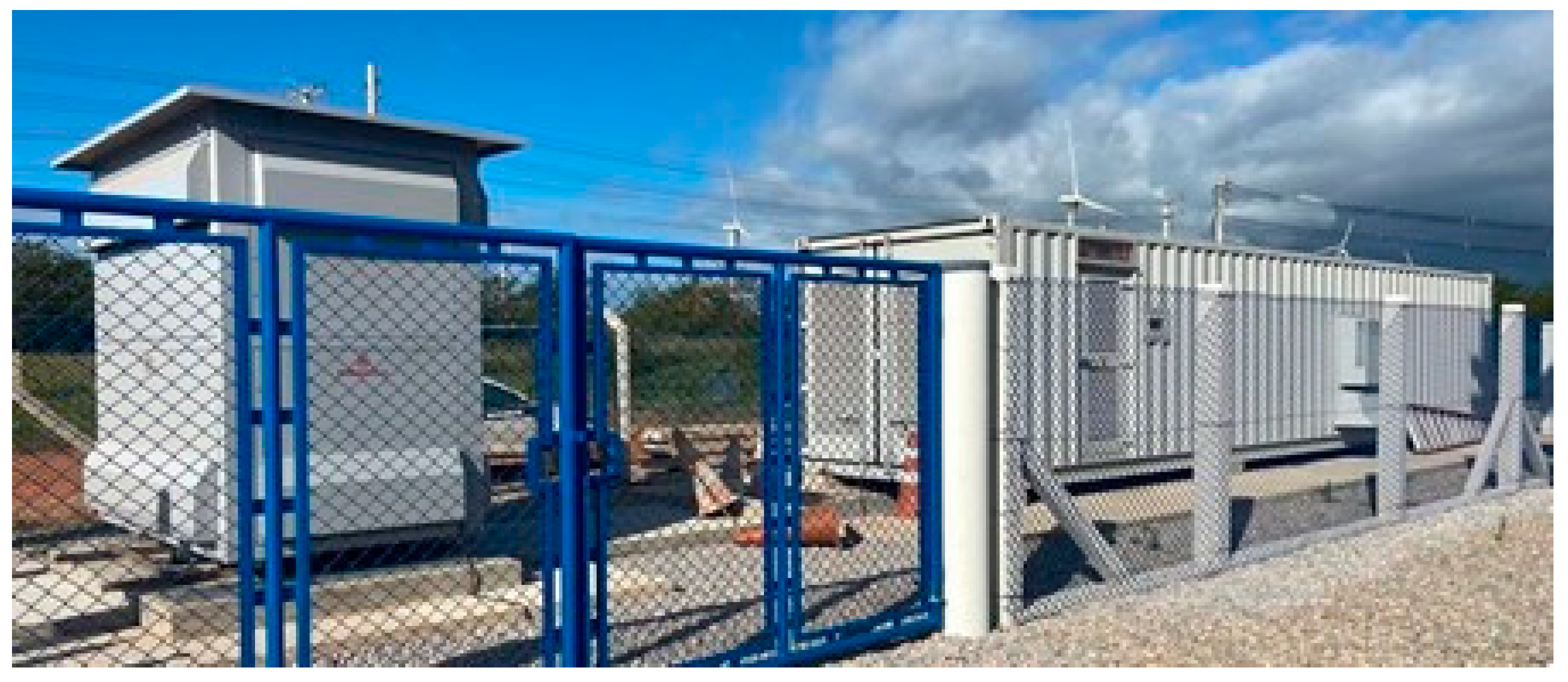

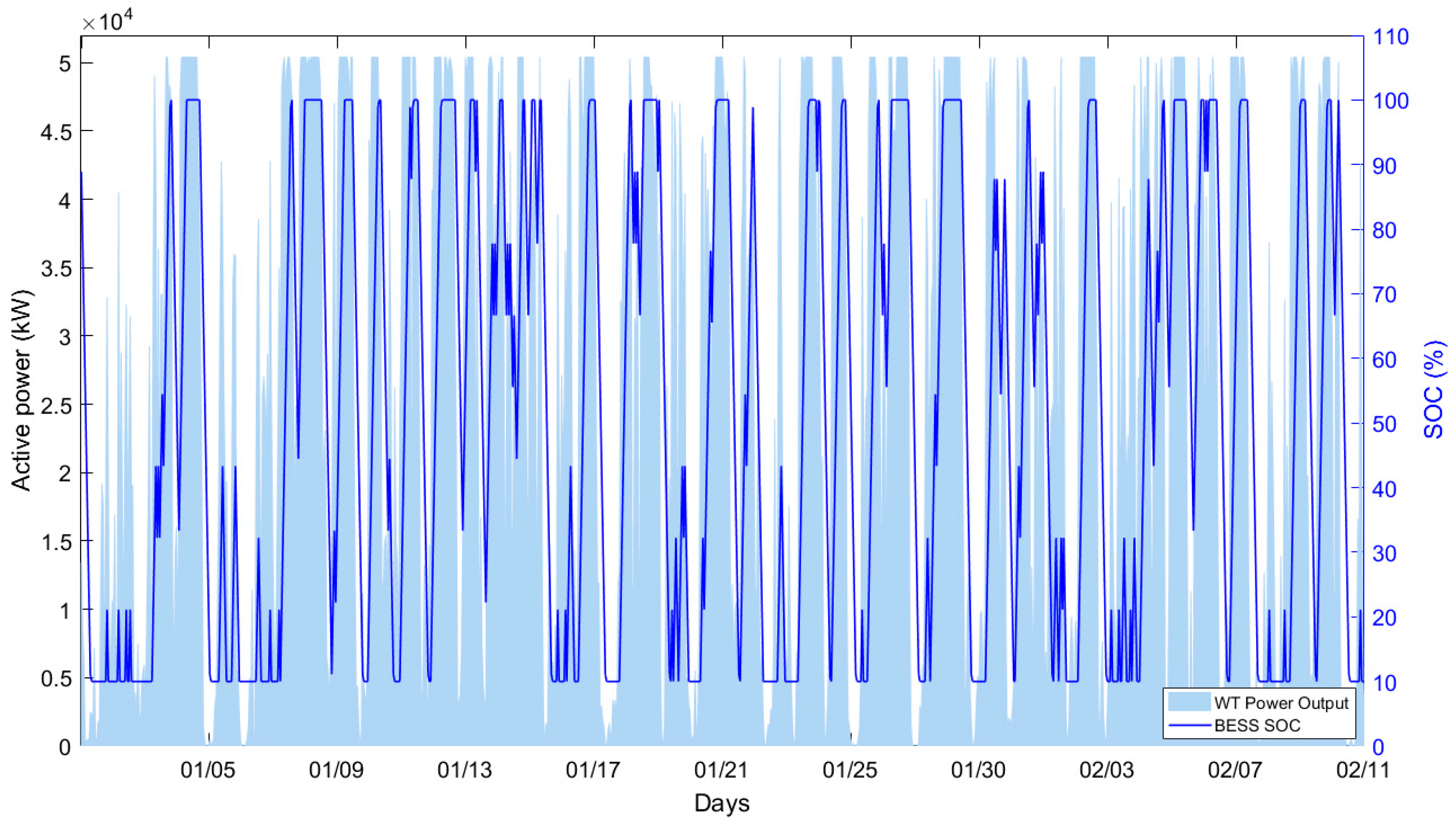
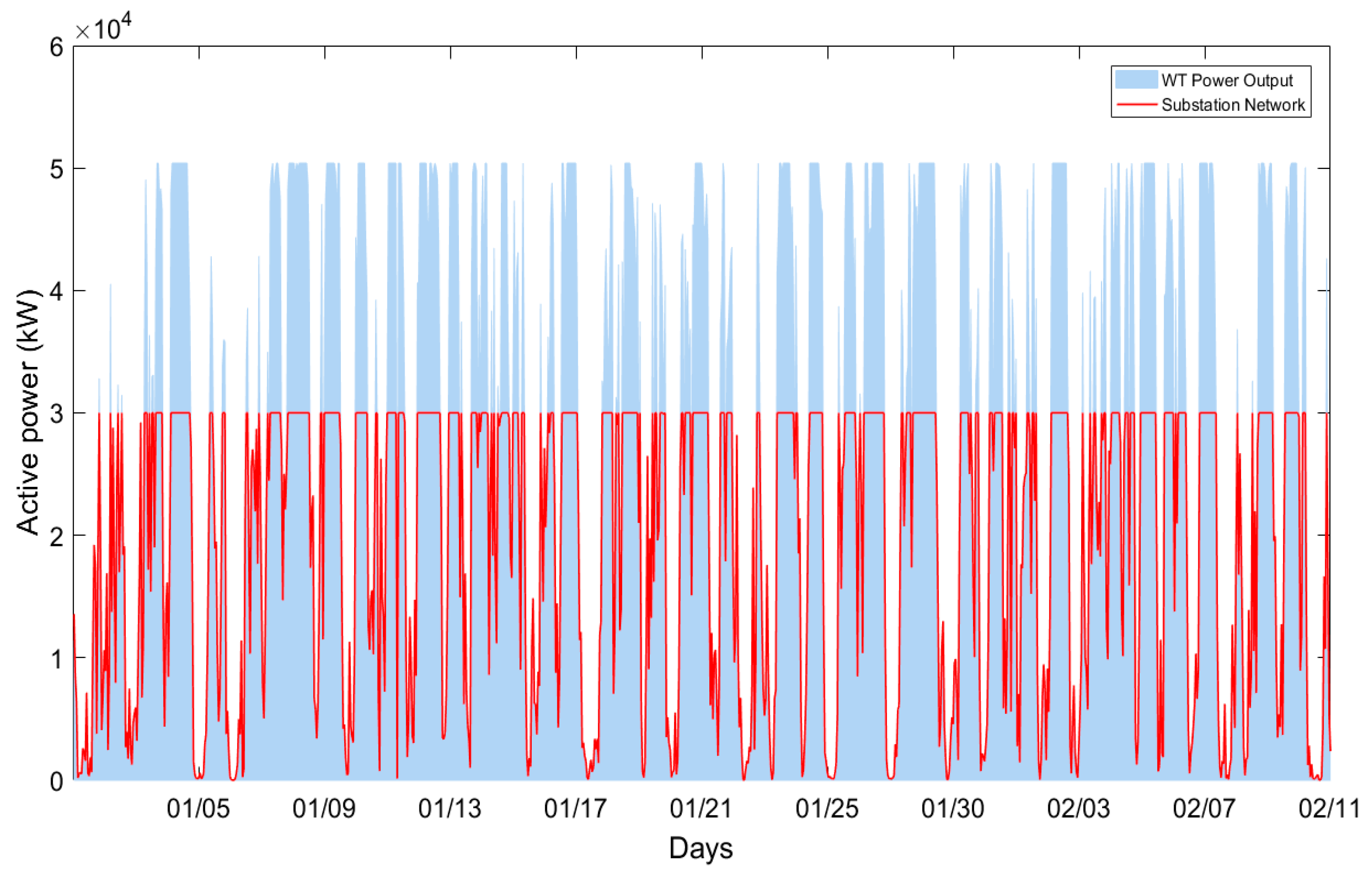
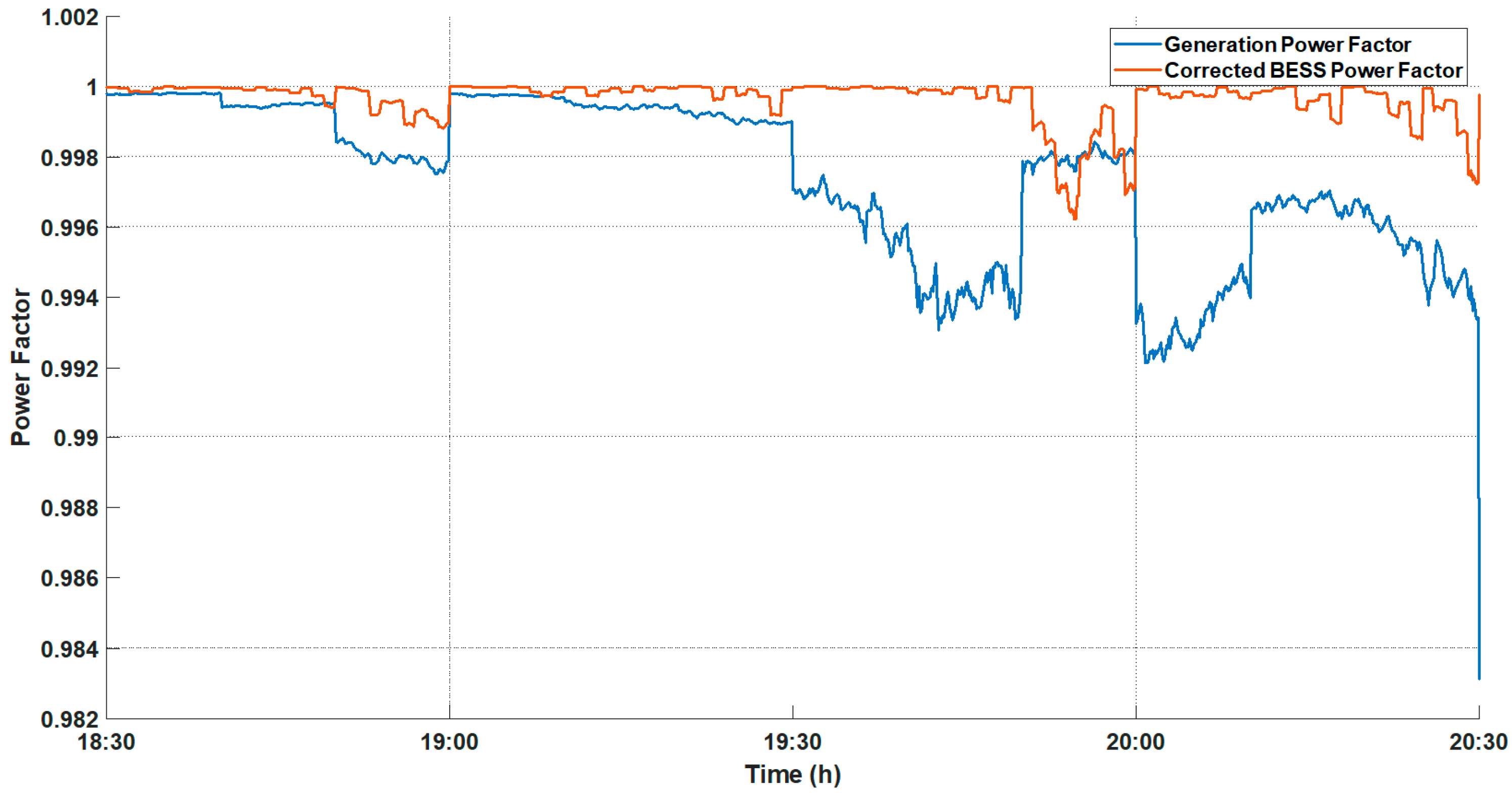

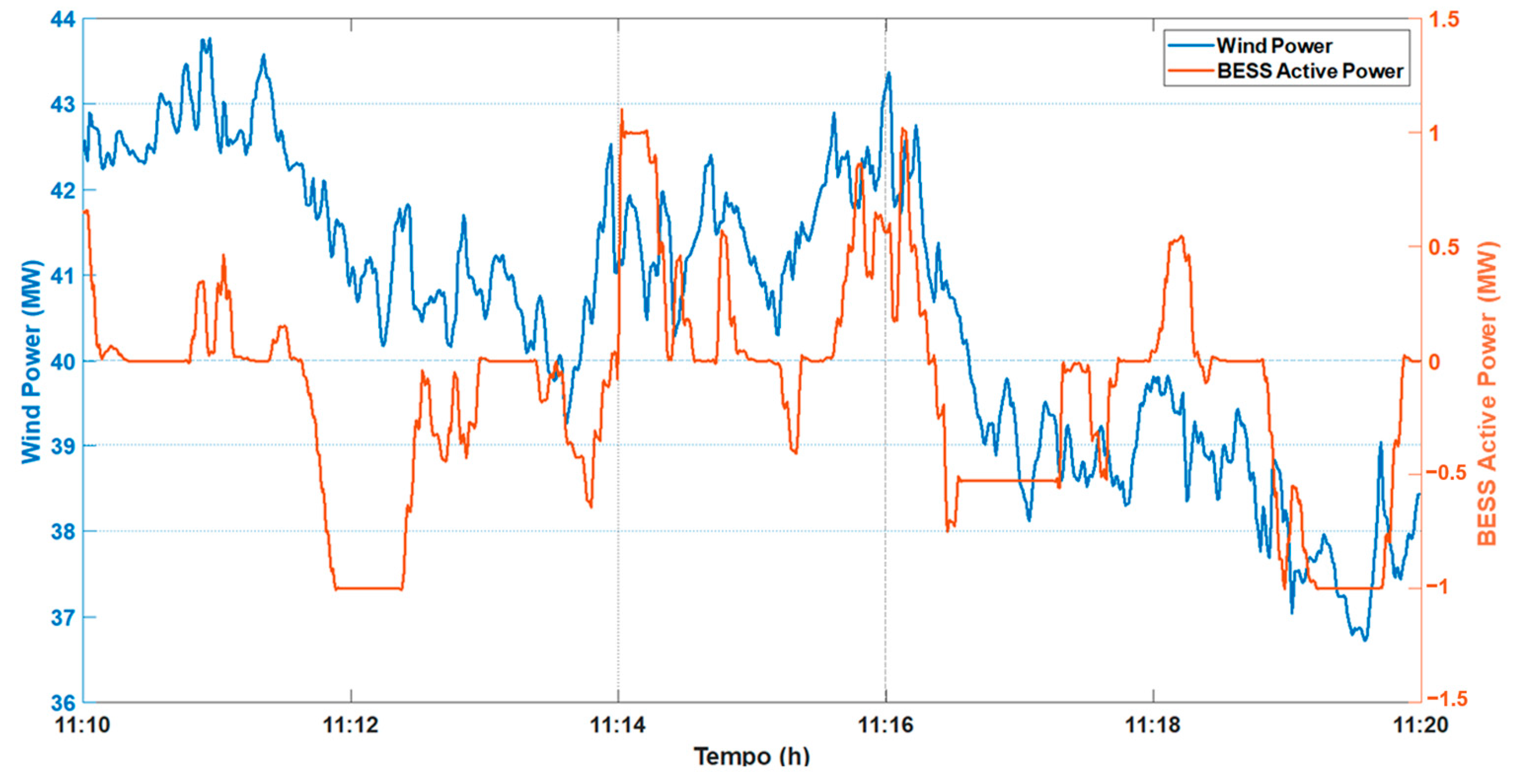
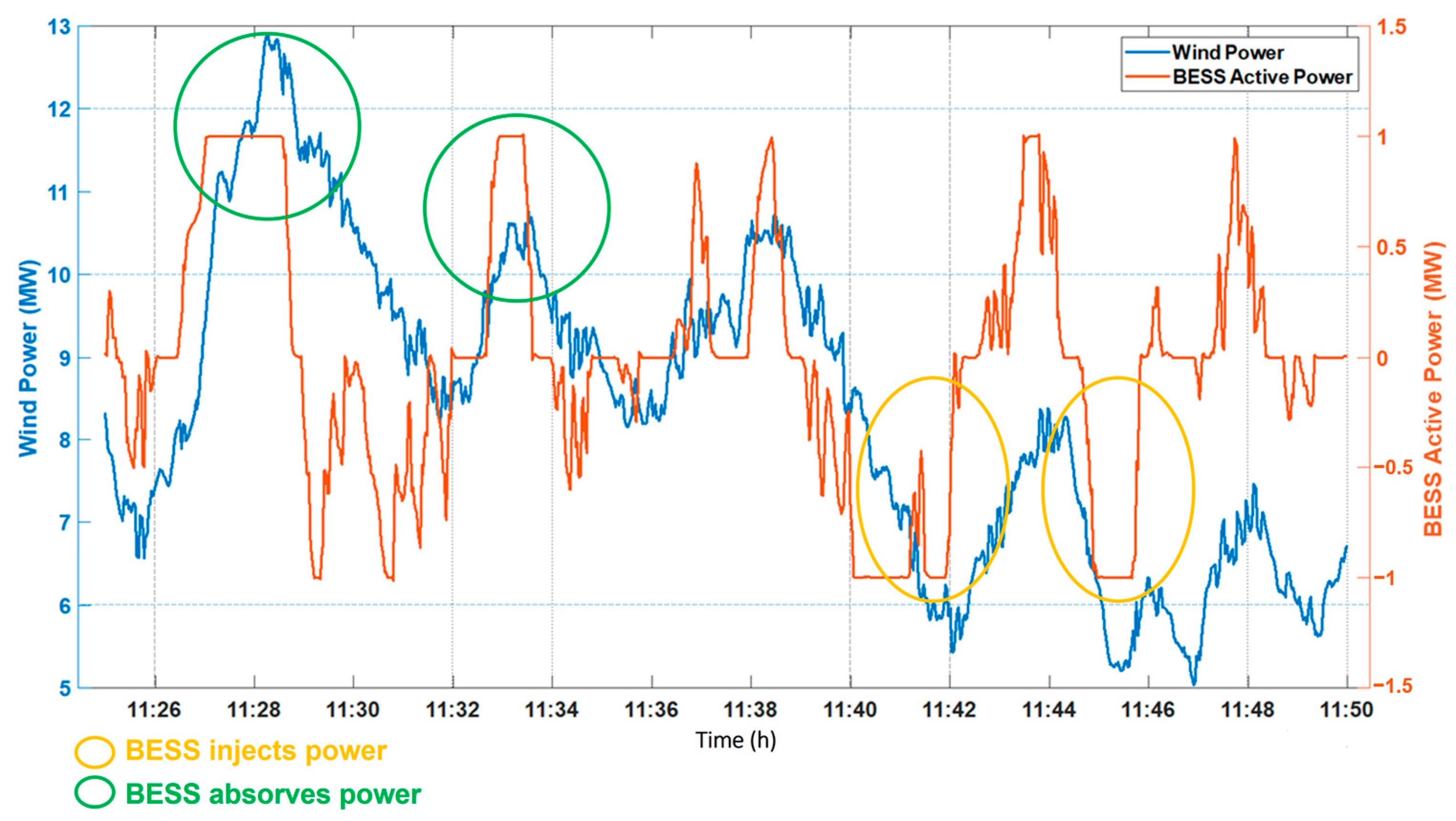
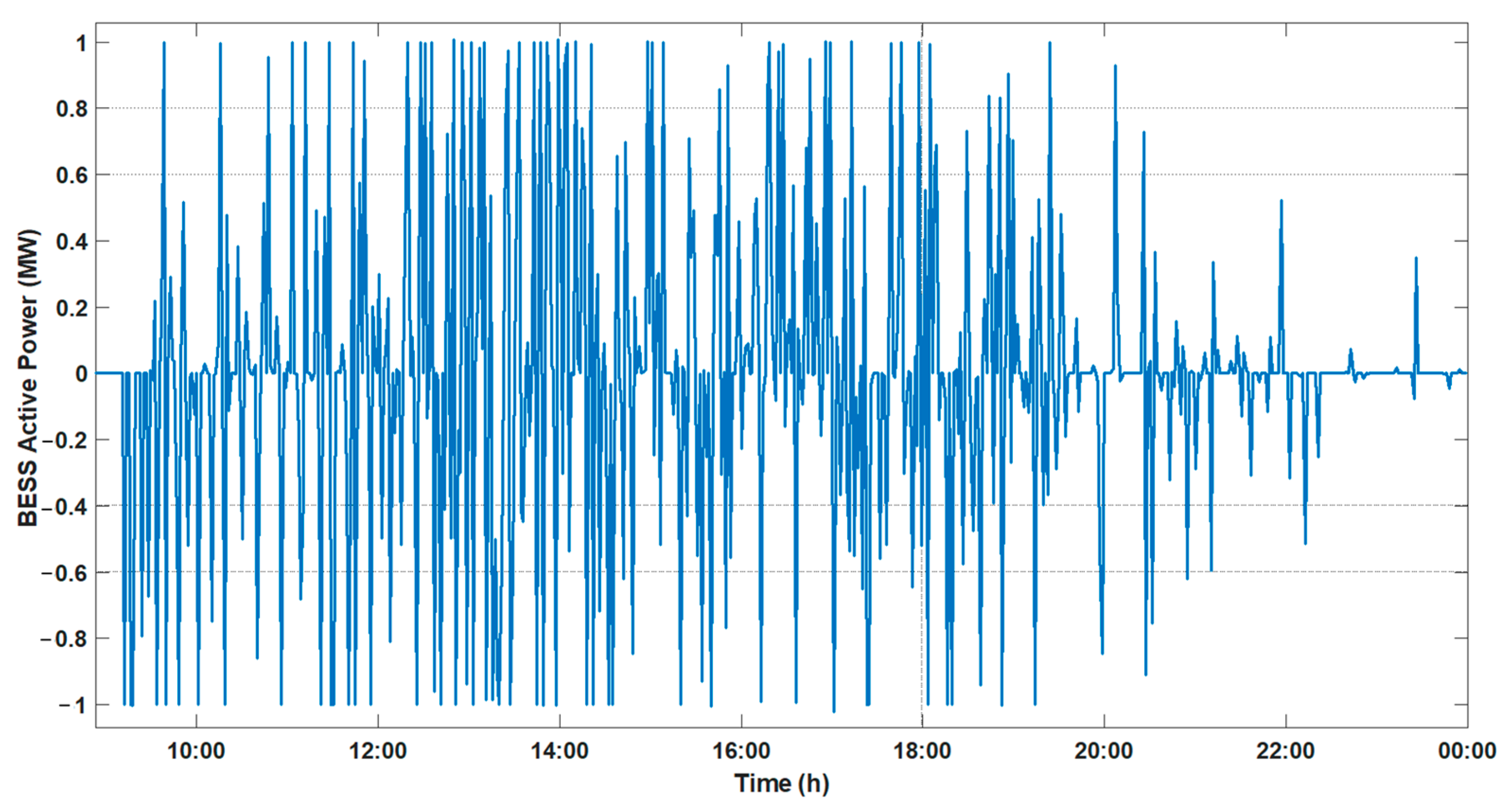
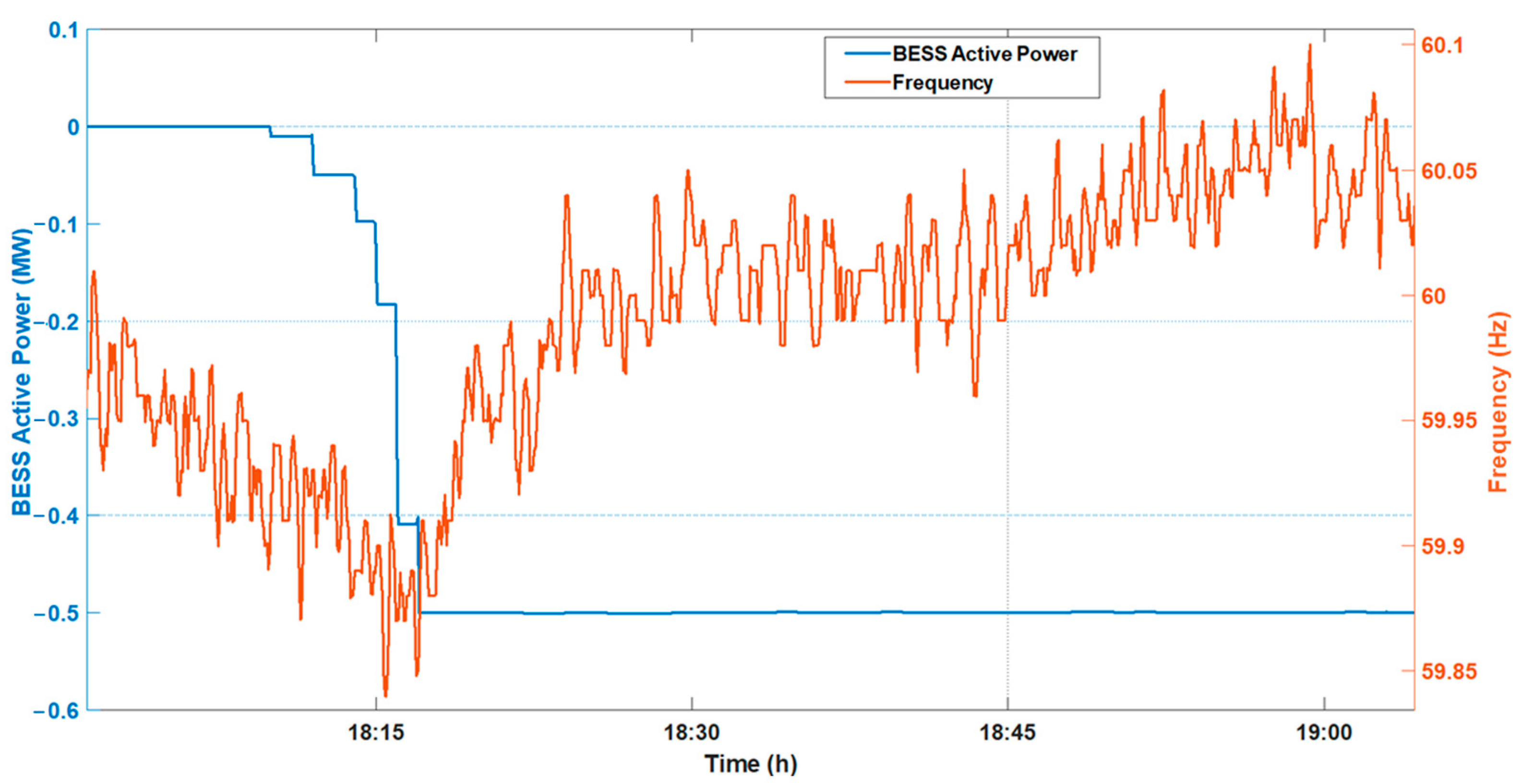
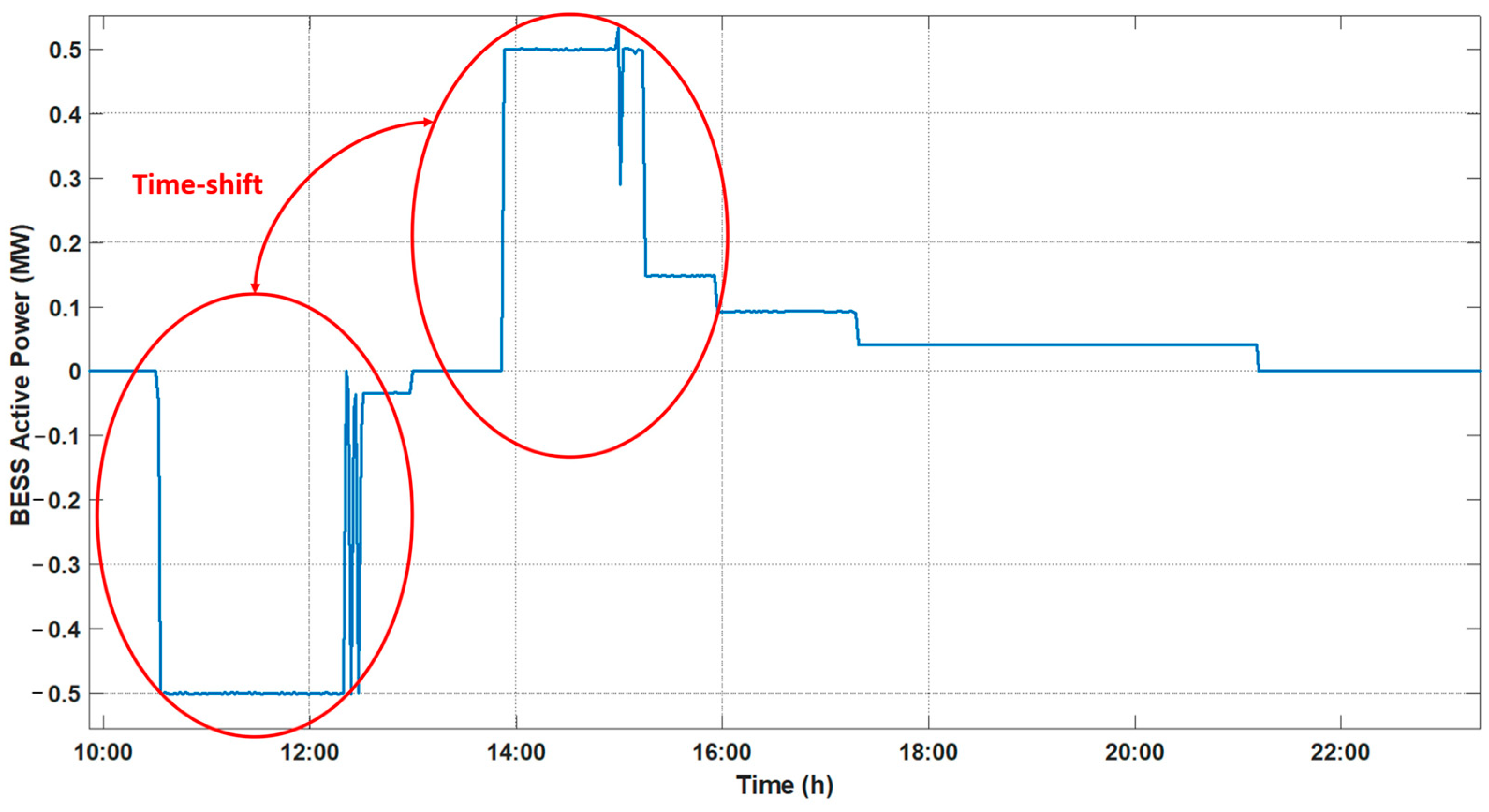
| Application | Description |
|---|---|
| Time-shift | This application aims to store energy in periods where there is high production and low demand (off-peak hours) and discharge when demand is higher and production is lower-peak hours. The BESS can also be recharged with excess energy production from renewable sources such as wind or photovoltaics and discharged in periods of high grid energy cost. |
| Frequency control | The frequency is affected or regulated by the system's active power balance, which is subject to faults and disturbances. A reserve amount of active power must be maintained that is dispatched promptly when required. This reserve is composed of dispatchable sources, which may be hydroelectric or natural gas plants, for example [21]. With the diversification of the energy matrix, renewable energies are connected with dispatchable sources. Wind energy, as it depends on weather conditions, is of the non-dispatchable type, and, in this way, the generated energy presents a high variation of active power that is injected directly into the electrical grid, affecting the frequency limits. When the BESS stores the energy produced in excess by renewable generation, it prevents the grid frequency from increasing and allows the energy to be dispatched when the grid needs to meet a demand greater than what is produced, preventing the frequency from decreasing [22]. |
| Voltage control | The voltage fluctuation resulting from the wind generation variation can be solved through the BESS; however, different from the frequency control, which uses active power, the voltage control is given by the reactive power, which can be injected into the electrical system through the power of the converter of the storage system. When the voltage deviation is less than (voltage limit value, given by the operator of the generation, transmission, or distribution system), it means that the value is within the regular operating range. |
| Spinning reserve | Spinning reserve is the difference between the total power of the synchronized generating stations in the system and the total system demand at a given moment. This application allows the BESS to inject into the system when production is low or when there is a system shutdown, supporting the most critical case of loss of generation and enabling wind energy to be more reliable for the power grid [23]. |
| LVRT | Low-voltage ride-through is used to prevent the system from collapsing when a voltage dip occurs. Wind turbines need to remain connected to the power grid, providing reactive support and increasing the voltage at the connection point. A BESS can also be used to provide this support to the power grid, as it has bidirectional converters. This characteristic of the converters expands the number of control strategies, as the control system needs to consider whether the BESS is loading or unloading [24]. |
| Synthetic inertia | Traditional energy sources (synchronous generators) often have their own inertia, tending to maintain movement even when power is no longer applied. This property is essential for the stability of the electrical system, but it is not present in renewable sources since the connection to the network occurs through DC/AC converters that do not have this function. Therefore, the growth of renewable sources reduces the inertia of the electrical system, making it more vulnerable to changes in frequency. Using a BESS can provide fast responses, allowing dynamic control of the frequency [25,26]. The storage system, as it contains converters that operate in four quadrants, can inject and absorb power in a time range that can vary from milliseconds to seconds after a disturbance. In this way, the BESS serves as synthetic/virtual inertia, managing to mitigate frequency variation problems during a short period of time [27]. |
| Streaming support | Wind farms that are not located near the load center tend to have problems when a larger wind generation capacity is installed at a point where the transmission lines do not have enough transport capacity, causing it to be unfeasible to transmit the generated energy to the load, wasting part of this energy [25,28]. The use of the BESS with the wind farm allows the available line to have a better use, as the storage system supports the connection of a park with a maximum production higher than that available for the transmission line, in addition to helping to increase the load capacity of the line without increasing the transmission capacity [29]. |
| Backup | A BESS can be used as a backup, that is, to act as emergency support to the wind system when there is a wind generation deficit due to the low production of the park. Furthermore, it can also be used when it is necessary to perform preventive or corrective maintenance on a wind turbine. Thus, when removing a machine, a BESS can momentarily replace it to sustain the park operations without reducing the power delivered to the grid. This continuous operation maintains stable costs arising from the sale of energy, reducing the incidence of fines for the non-delivery of energy purchased by agents of the Brazilian interconnected system [30]. |
| Power factor smoothing | Due to the intermittency of generation from a renewable source, the power fluctuation is unpredictable and may vary over seconds, minutes, or even hours. As the share of renewable energy in the electrical network grows, the operation of these sources in the grid becomes more complex. The smoothing of the active power at the source output is one of the ways to allow stability in the network, as well as energy quality. The BESS can act to inject or absorb the power to maintain this variable within the established limits [22,31]. |
| Power factor correction | In Brazil, the power factor must be within the specified range of 0.95 inductive and 0.95 capacitive. In this case study, the BESS energy management system (EMS) verifies the power factor information generated by the wind turbines on the bus where the storage system is connected, and when there is a reduction in the power factor (less than 1), it triggers the two PCS contained in the BESS to operate with inductive or capacitive characteristics, depending on the behavior of the power factor. It should be noted that the programming of the BESS power factor correction function is programmed to act if the power factor is less than 1. |
| Variable | Value (kV) | Note |
|---|---|---|
| 38.0 | Upper voltage limit | |
| 34.0 | - | |
| 33.8 | - | |
| 31.0 | Lower voltage limit |
| Case | Time Interval | Maximum Power Value (MW) | Minimum Power Value (MW) | Wind Generation Rated Power (MW) | MVP Indicator (%) |
|---|---|---|---|---|---|
| Without BESS operation | 09:30 to 09:35 | 19.21 | 13.24 | 50.4 | 11.85 |
| 11:26 to 11:31 | 12.80 | 07.60 | 50.4 | 10.32 | |
| 11:40 to 11:45 | 08.05 | 05.55 | 50.4 | 4.96 | |
| 12:30 to 12:35 | 16.00 | 10.04 | 50.4 | 11.83 | |
| 13:05 to 13:10 | 20.37 | 10.19 | 50.4 | 20.20 | |
| 13:15 to 13:20 | 25.48 | 15.75 | 50.4 | 19.31 | |
| 13:45 to 13:50 | 22.02 | 14.01 | 50.4 | 15.89 | |
| 14:45 to 14:50 | 38.80 | 32.69 | 50.4 | 12.12 | |
| 16:25 to 16:30 | 46.28 | 42.08 | 50.4 | 8.33 | |
| With BESS operation | 09:30 to 09:35 | 18.53 | 13.92 | 50.4 | 9.15 |
| 11:26 to 11:31 | 11.08 | 07.90 | 50.4 | 6.31 | |
| 11:40 to 11:45 | 09.05 | 06.55 | 50.4 | 4.96 | |
| 12:30 to 12:35 | 15.00 | 10.36 | 50.4 | 9.21 | |
| 13:05 to 13:10 | 19.37 | 10.43 | 50.4 | 17.74 | |
| 13:15 to 13:20 | 24.48 | 16.75 | 50.4 | 15.34 | |
| 13:45 to 13:50 | 21.02 | 14.94 | 50.4 | 12.06 | |
| 14:45 to 14:50 | 37.89 | 33.69 | 50.4 | 8.33 | |
| 16:25 to 16:30 | 45.63 | 42.80 | 50.4 | 5.62 |
| Variable | Value (Hz) | Note |
|---|---|---|
| 60.5 | Upper frequency limit | |
| 60.2 | - | |
| 60.1 | - | |
| 59.7 | Lower frequency limit |
Disclaimer/Publisher’s Note: The statements, opinions and data contained in all publications are solely those of the individual author(s) and contributor(s) and not of MDPI and/or the editor(s). MDPI and/or the editor(s) disclaim responsibility for any injury to people or property resulting from any ideas, methods, instructions or products referred to in the content. |
© 2023 by the authors. Licensee MDPI, Basel, Switzerland. This article is an open access article distributed under the terms and conditions of the Creative Commons Attribution (CC BY) license (https://creativecommons.org/licenses/by/4.0/).
Share and Cite
Pontes, L.; Costa, T.; Souza, A.; Dantas, N.; Vasconcelos, A.; Rissi, G.; Dias, R.; Mohamed, M.A.; Siano, P.; Marinho, M. Operational Data Analysis of a Battery Energy Storage System to Support Wind Energy Generation. Energies 2023, 16, 1468. https://doi.org/10.3390/en16031468
Pontes L, Costa T, Souza A, Dantas N, Vasconcelos A, Rissi G, Dias R, Mohamed MA, Siano P, Marinho M. Operational Data Analysis of a Battery Energy Storage System to Support Wind Energy Generation. Energies. 2023; 16(3):1468. https://doi.org/10.3390/en16031468
Chicago/Turabian StylePontes, Luana, Tatiane Costa, Amanda Souza, Nicolau Dantas, Andrea Vasconcelos, Guilherme Rissi, Roberto Dias, Mohamed A. Mohamed, Pierluigi Siano, and Manoel Marinho. 2023. "Operational Data Analysis of a Battery Energy Storage System to Support Wind Energy Generation" Energies 16, no. 3: 1468. https://doi.org/10.3390/en16031468
APA StylePontes, L., Costa, T., Souza, A., Dantas, N., Vasconcelos, A., Rissi, G., Dias, R., Mohamed, M. A., Siano, P., & Marinho, M. (2023). Operational Data Analysis of a Battery Energy Storage System to Support Wind Energy Generation. Energies, 16(3), 1468. https://doi.org/10.3390/en16031468








